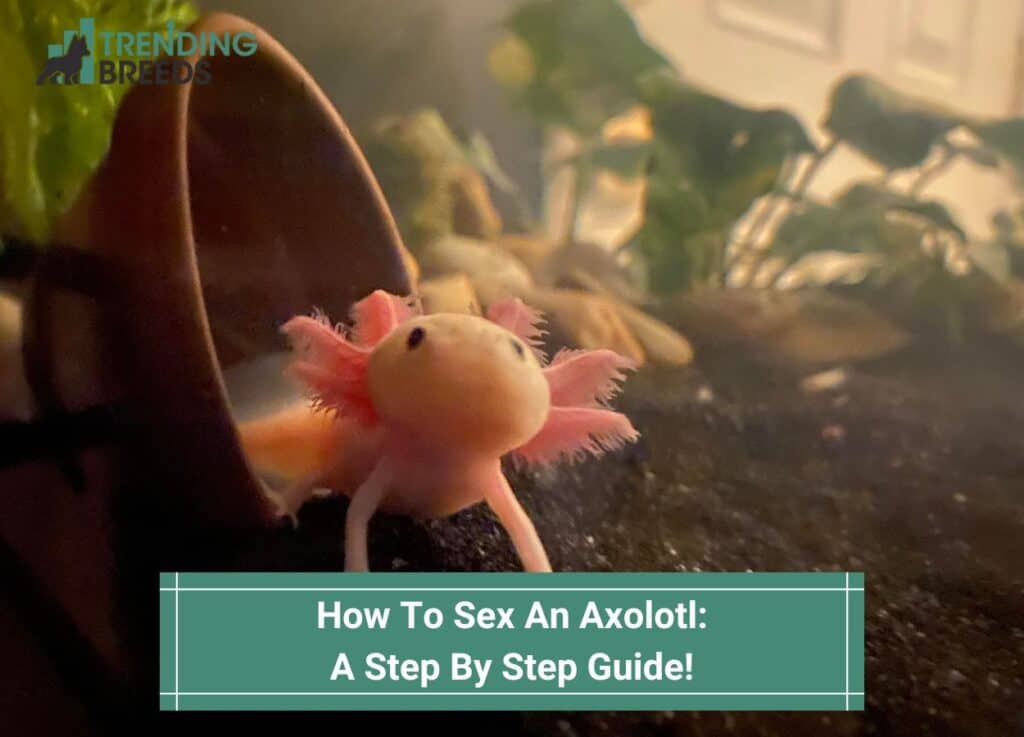
Unsurprisingly, one frequently asked question for Axolotl owners is, “How to sex an Axolotl?”
Axolotls are notoriously challenging to sex, and it can be tricky to identify their gender.
Unlike some animals like dogs, where distinguishing between males and females is relatively straightforward (such as the presence of male genitalia), the physical differences between male and female axolotls are subtle, especially to the untrained eye.
It is possible to determine the sex of your axolotl when you know what characteristics to observe and when to monitor them.
Read on to learn more.
Before you scroll further down this guide, check out these other animal-related articles: How To Groom A Belgian Malinois and How To Tell If Your Rat Is Too Skinny?.
Table of Contents
When Is It Possible to Tell an Axolotl’s Sex?

When you bring a new pet into your life, one of the initial considerations is selecting a suitable name.
However, determining the sex or gender of an Axolotl, mainly when they are juveniles, can be pretty challenging.
That complicates the naming process unless you opt for a gender-neutral name.
So, how can you determine the sex of an Axolotl?
Sexing an Axolotl becomes more manageable as the creature matures and reaches sexual maturity.
In other words, it is only possible to determine the sex of an Axolotl at a later stage in its life cycle.
Sexual Maturity
To ascertain the sex of your Axolotl, you will likely need to wait until it reaches sexual maturity, as attempting to determine its sex before that stage would mainly involve guesswork.
Sexual maturity refers to an organism’s ability to reproduce. Generally, we consider an animal to have reached adulthood when it becomes sexually mature.
Age

As a general rule, Axolotls typically reach sexual maturity between 6 to 12 months of age.
However, there can be variations, with some individuals becoming sexually mature as early as five months, while others may take several years to reach that stage.
The rate at which an Axolotl attains sexual maturity depends on genetics and factors such as water quality and diet quality.
Size
During the stage of sexual maturity in their lifecycle, Axolotls typically reach an average size of around 8 inches or approximately 20 cm.
This size range gives a general indication of the growth progression for Axolotls at that particular stage.
Coloration

When Axolotls reach sexual maturity, one noticeable change that may occur is the coloration of their toes.
That can serve as a reliable indicator that your Axolotl is transitioning into adulthood.
In general, the toes of lighter-colored Axolotls will start to darken, while the toes of darker-colored axolotls will begin to lighten in color.
This color change in the toes is a common phenomenon observed during the maturation process of Axolotls.
Can You Sex a Baby Axolotl?
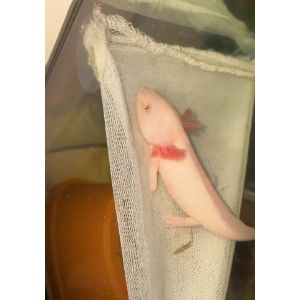
Determining the sex of an Axolotl is widely recognized as a challenging task, and it becomes even more difficult to do so before they reach sexual maturity.
In general, attempting to sex with a baby Axolotl is not fruitful. It is advisable to wait until they are at least 6 to 8 months old before trying to identify their gender.
Now that you understand the limitations of sexing a juvenile axolotl and the importance of waiting until they are sexually mature let’s explore the various indicators you can observe to determine whether your Axolotl is male or female.
How to Tell an Axolotl’s Sex (Male vs. Female Axolotl)

Watch Your Axolotls Breed
One of the distinctive ways to determine the gender of an Axolotl is by observing its breeding behavior.
Males and females exhibit different behaviors during mating, which can help identify their gender.
Male Axolotls engage in tail wiggling, releasing spermatophores and sperm cones spread throughout the tank. They actively move around, laying these sperm cones.
On the other hand, females tend to follow the males closely, pressing their noses against the males’ cloaca.
Males will attempt to nudge and push the female towards the sperm cone, aiming for the sperm to enter her body.
Once absorbed, the female will begin depositing and laying eggs throughout the tank over an extended period.
By observing this mating process, you can discern the behavior of the Axolotls and determine the male and female individuals.
Aggressive behavior during mating suggests a male, while an Axolotl laying eggs is almost certainly a female.
However, it’s important to note that this method relies on having male and female Axolotls in the same tank during mating season.
Consequently, it may not be a reliable method for sexing your Axolotl.
Check Your Axolotl’s Cloaca
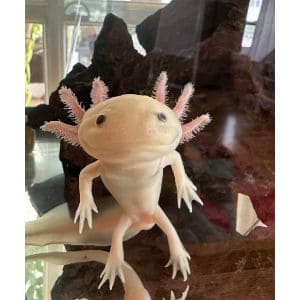
Another simple method to determine the gender of your Axolotl is by examining the cloaca, which is the area located behind the back legs, just before the tail.
In female Axolotls, the cloaca is typically flat against the body, with no noticeable bulge near the tail.
However, females may occasionally have a slight swelling called a “poop bump” on the cloaca, or the area may sag down in a V or U shape.
It is important to note that these characteristics are not prominent bulges. The cloaca in females is also shorter in length compared to males.
After defecation, the poop bump should subside, and the cloaca will return to its normal flat appearance.
On the other hand, once an Axolotl reaches sexual maturity, male individuals will develop a noticeable bulge in the cloaca area.
This bulge will be just behind the back legs, before the tail. While the size and definition of the node may vary among males, all males will have one.
Furthermore, male Axolotls tend to have more extended cloaca areas compared to females, and the bulge becomes more prominent and defined during the breeding process.
Examining the cloaca and observing the presence or absence of a bulge can provide valuable clues to differentiate male and female Axolotls.
Look At Your Axolotl’s Body Shape
Another method to determine the sex of your Axolotl is by examining their body shape, as it can differ between males and females.
When observing the silhouette of an Axolotl, it is best to view them from above.
Female Axolotls typically have a rounder body shape compared to males. Females have evolved to carry eggs, and their bodies can accommodate this function.
Consequently, their stomach area and body width tend to be slightly broader. Some female Axolotls may appear pear-shaped, particularly when carrying eggs after mating.
Females may reabsorb the eggs in cases where no mating occurs, leading to a rounder appearance.
This characteristic roundness is typically more evident in females throughout their lives. In contrast, male Axolotls tend to have a slimmer and thinner body shape than females.
Furthermore, the body shape can aid in identifying the cloaca, as the bulge in males is noticeably more pronounced and contrasts with the rest of the body.
By examining the body shape, particularly from an overhead perspective, you can gather additional clues to help determine the gender of your Axolotl.
Compare The Sizes Of Your Axolotls

Another method to consider is checking the size of your Axolotls. In general, female Axolotls tend to be larger and longer than males.
However, it’s important to note that this size difference is inconsistent, so it cannot be solely relied upon for accurate sex determination.
Using this method in conjunction with other techniques mentioned earlier is advisable.
Occasionally, some males can grow to be quite large due to genetic factors or their diet.
Therefore, it is possible to have two Axolotls of roughly the same length, one male and one female.
In such cases, the female will still exhibit a rounder appearance, while the male may appear slimmer and scrawnier.
While size can provide some clues about the sex of an Axolotl, it is part of a comprehensive assessment along with other observable characteristics.
Can Axolotls Change Sex?
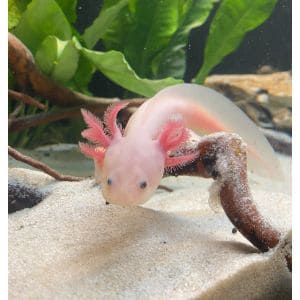
Axolotls cannot change their sex. They are born with a specific sex, male or female, determined by the chromosomes they inherit from their parents.
Once their sex is selected, it remains fixed for their entire lives. Axolotls cannot change or transition from one sex to another.
FAQs About Axolotl Sex

How can I tell if my Axolotl is male or female?
Determining the sex of an Axolotl can be challenging, especially when they are young or juveniles.
However, there are several methods you can use to try and identify the gender of your Axolotl:
- Wait for sexual maturity: Axolotls typically reach sexual maturity between 6 to 12 months of age. At this stage, their sexual characteristics become more apparent.
- Observe breeding behavior: Males and females exhibit different behaviors during breeding. Males wiggle their tails and deposit spermatophores (sperm cones) around the tank, while females follow them closely with their noses near the cloaca. Males will try to push the female onto the sperm cone for fertilization, and females will lay eggs.
- Examine the cloaca: The cloaca is the area behind the back legs, just before the tail. In females, the cloaca is typically flat against the body, while males have a noticeable bulge in the cloaca area.
- Consider body shape: Females tend to have a rounder body shape, especially in the stomach area, to accommodate egg-carrying. Males, on the other hand, appear slimmer and thinner in comparison.
- Look for size differences: Generally, females are more prominent and more prolonged than males. However, this method is only sometimes reliable as some males can grow large due to genetics or diet.
It is important to note that these methods may not provide definitive results, especially in young Axolotls.
Using a combination of these techniques can increase the likelihood of accurately determining the sex of your axolotl.
If unsure, consulting a veterinarian or experienced Axolotl breeder can provide further guidance.
How old do Axolotls have to be for sex?
Axolotls typically need to reach sexual maturity before you can reliably sex them.
The age at which Axolotls reach sexual maturity can vary, but it generally falls within the 6 to 12 months range.
During this time, the Axolotls undergo physical and behavioral changes that indicate their readiness for reproduction.
These changes include the development of secondary sexual characteristics, such as the formation of cloacal bulges in males and a rounder body shape in females.
It is important to note that attempting to sex with Axolotls before they reach sexual maturity can be quite challenging and may lead to inaccurate results.
Waiting until they are at least 6 to 12 months old provides a better opportunity to observe and identify the distinguishing characteristics associated with their gender.
Remember that the timing of sexual maturity can depend on various factors, including genetics and environmental conditions.
It is always a good idea to monitor the development of your axolotls and consult with experienced axolotl enthusiasts or veterinarians for guidance on sexing them accurately.
Can two male Axolotls live together?
While it is generally not recommended to keep two male Axolotls together, there are some factors to consider before making a decision.
Male axolotls can exhibit territorial and aggressive behavior, especially when they reach sexual maturity.
They may engage in aggressive interactions, such as biting or nipping, which can lead to injuries or stress for both individuals.
Keeping two male Axolotls in the same tank increases the likelihood of territorial disputes and can negatively impact their overall well-being.
Suppose you decide to house multiple male Axolotls together.
In that case, providing a spacious tank with plenty of hiding spots, separate feeding areas, and ample room for each Axolotl to establish its territory is crucial.
However, even with these precautions, conflicts may still arise, and close monitoring is necessary to ensure their safety.
Keeping male and female Axolotls together or housing them is generally easier and less stressful to avoid potential aggression and territorial issues.
Suppose you want to have multiple Axolotls in the same tank.
In that case, it is often best to consider a mixed-gender group or to keep them in separate enclosures to ensure their well-being and minimize the risk of aggression.
How can I tell the age of my Axolotl?
Determining the exact age of an Axolotl can be challenging, especially if you acquired it as a juvenile or adult without knowledge of its birth date.
However, there are a few indicators you can use to estimate the age of your Axolotl:
Size
Axolotls grow at a predictable rate, especially during their early months.
By comparing your Axolotl’s size to growth charts or consulting Axolotl experts, you can get a rough estimate of its age. Keep in mind that growth rates can vary among individuals.
Developmental stage
Axolotls go through distinct developmental stages, and the presence or absence of specific features can provide insights into their age.
For example, the presence of gills indicates that the Axolotl is in its larval stage, while the development of the lungs suggests it has reached adulthood.
Sexual maturity
Axolotls typically reach sexual maturity between 6 to 12 months of age.
If your Axolotl has started exhibiting sexual characteristics, such as cloacal bulges in males or a rounder body shape in females, it suggests it is likely at least six months old.
Teeth condition
Axolotls develop teeth as they age, and their condition can give you an idea of their approximate age.
Younger Axolotls tend to have smaller, sharper teeth, while older individuals may have more worn-down or blunt teeth.
While these indicators can provide rough estimates, it is essential to note that accurately determining the age of an Axolotl without specific birth records or knowledge can be challenging.
If you are still choosing your Axolotl’s age, consulting with an experienced axolotl breeder or veterinarian can provide additional guidance based on their expertise and observations.
How are Axolotls born?
Axolotls, also known as Mexican walking fish, have a unique life cycle that involves an aquatic larval stage that persists into adulthood.
Their method of reproduction is through external fertilization.
The mating process begins when a receptive female Axolotl releases pheromones into the water to attract the attention of males.
The male axolotls detect these chemical signals and become stimulated to breed. They approach the female, and the courtship behavior begins.
During courtship, the male Axolotl wiggles its tail and deposits spermatophores (sperm cones) around the tank or substrate.
These spermatophores contain spermatozoa, which the female picks up through her cloaca.
The female Axolotl follows the male, positioning her cloaca near the spermatophore.
The male may push the female to ensure contact between her cloaca and the spermatophore, facilitating fertilization.
Once the eggs fertilize internally, the female Axolotl will begin to lay them.
The eggs are typically attached to various surfaces, such as plants or tank decorations. The female may lay hundreds of eggs, which can take several hours to deposit.
The fertilized eggs undergo development and hatch into aquatic larvae after a period of approximately 10 to 14 days.
The larvae have external gills that allow them to breathe in water. They remain in this larval stage, retaining their gills and aquatic adaptations.
It’s important to note that Axolotls can regenerate body parts, including limbs and organs.
This unique trait contributes to their popularity in scientific research and as captivating pets.
How To Sex An Axolotl: A Step By Step Guide
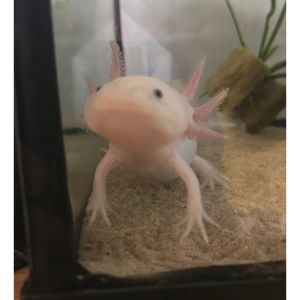
Understanding the sex, age, and reproductive process of Axolotls is essential for their proper care and management.
While sexing juvenile Axolotls can be challenging, it becomes easier as they reach sexual maturity.
Monitoring their growth, observing sexual characteristics, and witnessing breeding behaviors are valuable tools for determining their gender.
Axolotls exhibit fascinating reproductive behaviors, such as the deposition of spermatophores by males and the egg-laying process by females.
These external fertilization methods contribute to the successful reproduction of these unique creatures.
The ability to breed and produce offspring is a significant aspect of Axolotl life cycles.
Furthermore, accurately estimating the age of an axolotl can be complex, but considering factors such as size, developmental stage, sexual maturity, and tooth condition can provide reasonable approximations.
By gaining knowledge about these aspects of Axolotl biology, enthusiasts and pet owners can create suitable environments, anticipate breeding behaviors, and ensure the overall well-being of these fascinating amphibians.
Consulting with experts, such as Axolotl breeders or veterinarians, can provide additional guidance and support in understanding and caring for these captivating creatures.
If you find this guide, “How To Sex An Axolotl: A Step By Step Guide,” informative and helpful, you can check out these other animal-related articles from our team:
- How To Get Rid of Rat Urine Smell Fast and Easy?
- How To Put Your Cat on A Diet – Fast And Easy Steps
- How to Get an All White Cane Corso?
You can learn more about axolotls by watching “Facts: The Axolotl” down below:




